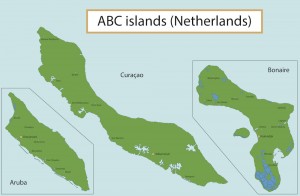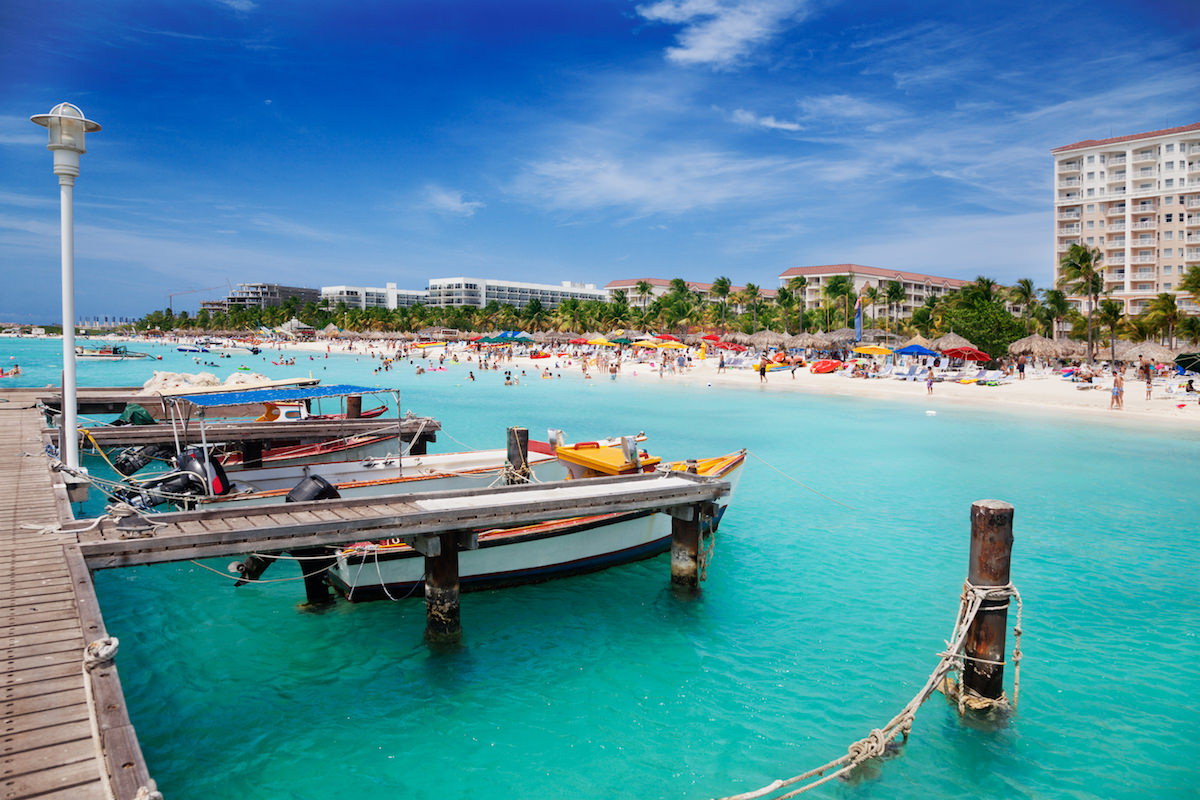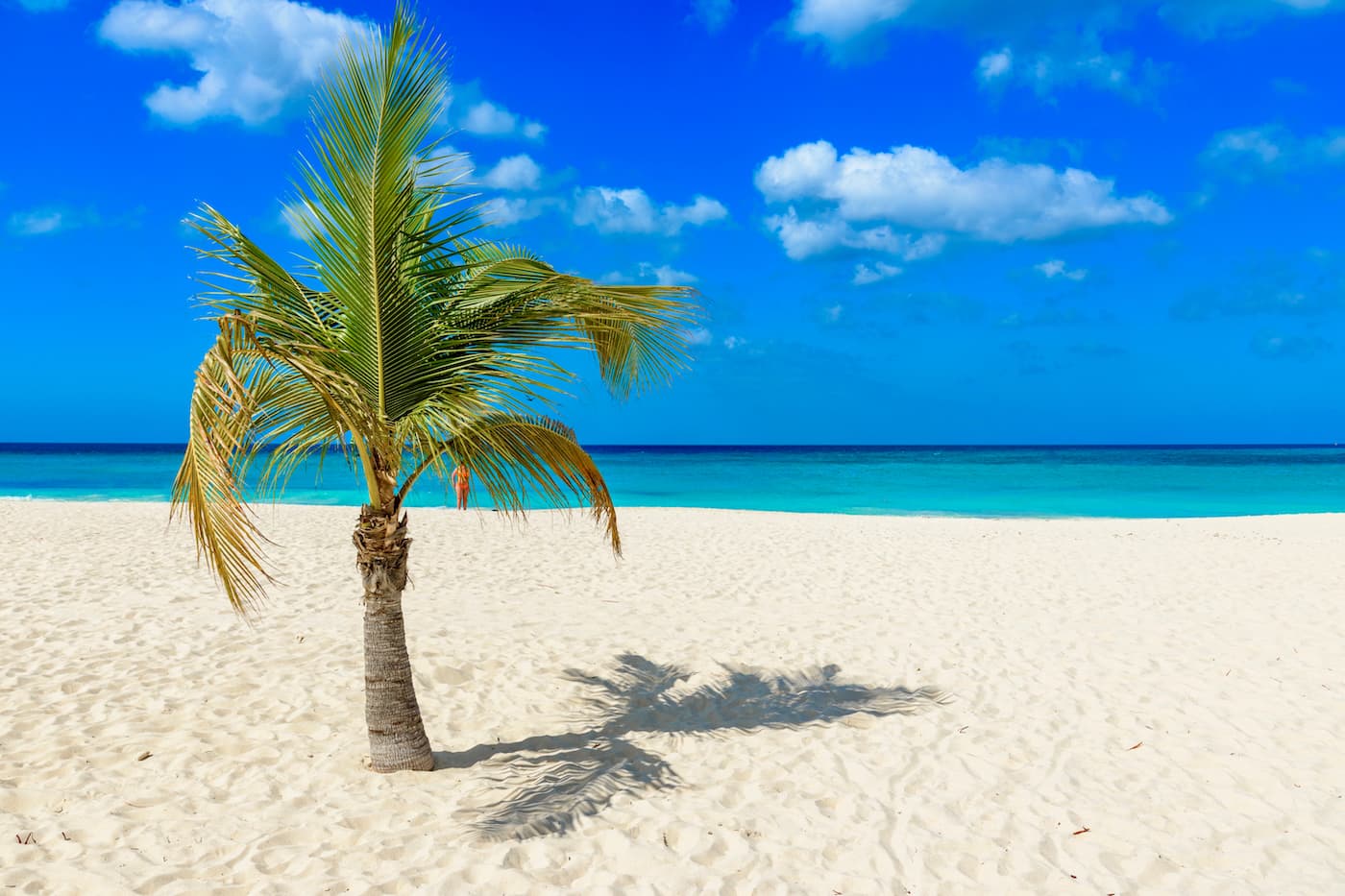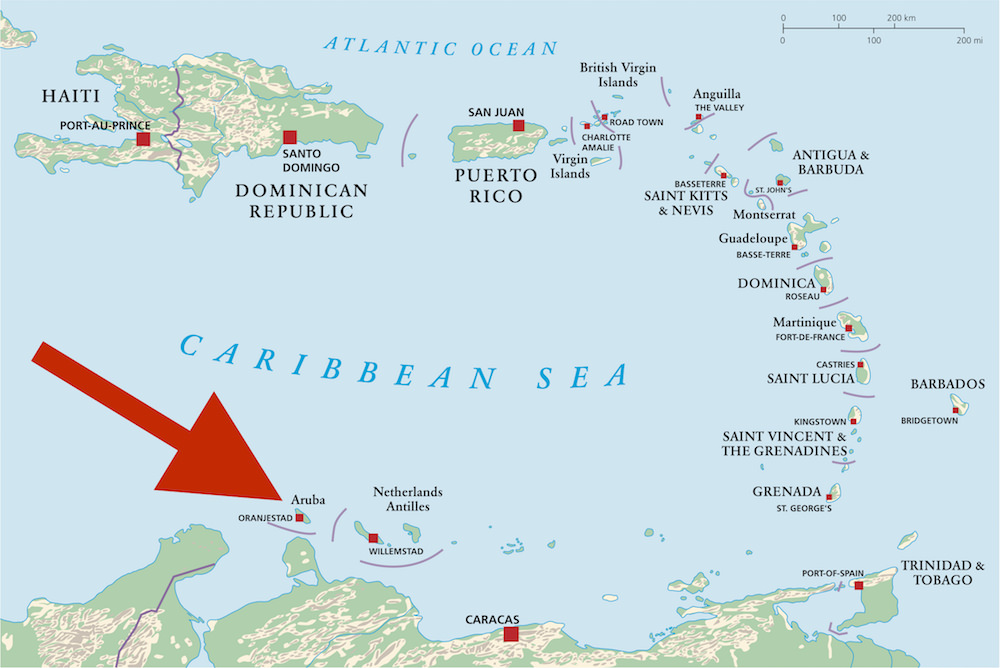
Where is Aruba Located?
Aruba, the Dutch Caribbean island famous for its white powdery beaches, is located just 15 miles (approximately 24 kilometers) north off the coast of the Paraguaná peninsula of northern Venezuela, South America. From the United States, Aruba is located about 1165 miles southeast of Ft. Lauderdale, Florida.
The island is situated in the southern Caribbean Sea, about 50 miles (81 kilometers) west of Curaçao, and about 108 miles (175 kilometers) west of Bonaire. Aruba is not surrounded by an ocean of its own. The surrounding ocean is the Caribbean Sea that is connected to the Gulf of Mexico to the northwest, and the Atlantic Ocean to the northeast. On clear days, you can see the Venezuelan mainland, looking to the south. The distance to the coast of Venezuela is only 15 miles!
What is Aruba Best Known For?
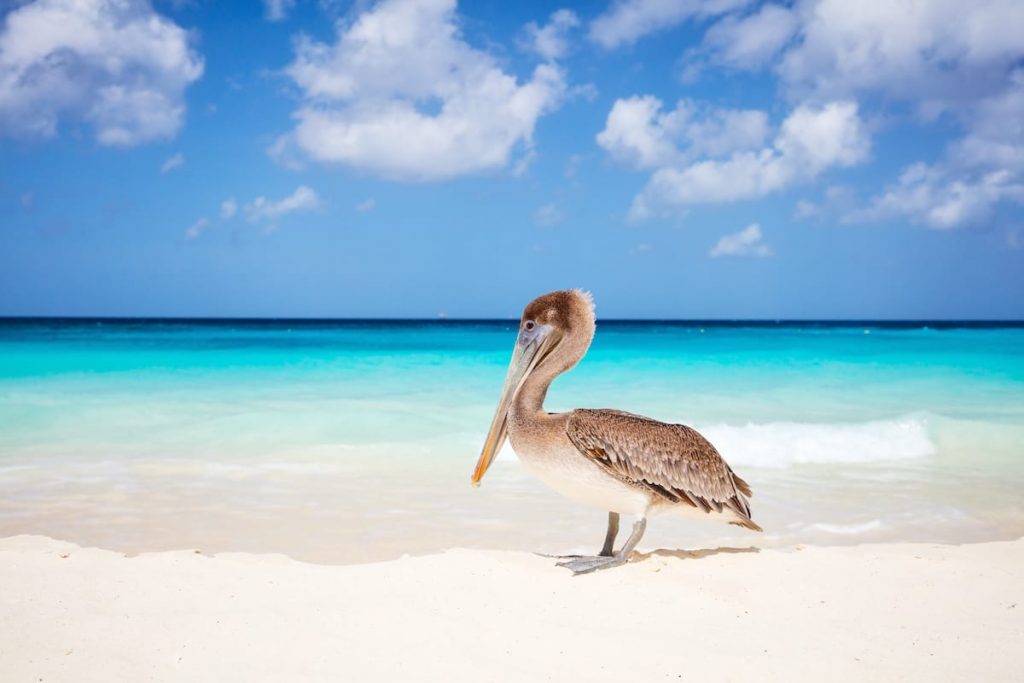
Some things Aruba is best known for include Eagle Beach, Palm Beach, and Baby Beach. Also, the island is a paradise for water sports enthusiasts. You can go snorkeling, scuba diving, windsurfing, and kitesurfing. Plus, Aruba is home to several top-notch casinos, making it a popular destination for gambling enthusiasts. Mother Nature has blessed the island with several natural attractions, such as Arikok National Park, which covers nearly 20% of the island, and the Natural Pool, a natural swimming hole surrounded by rugged cliffs. The population knows how to party, too, as Aruba hosts several festivals throughout the year, including the Aruba Carnival, one of the biggest and most colorful events in the Caribbean!
Map of Aruba Hotels
Related questions people are asking often are “Where is Aruba located on a map”, and “Aruba, where is it”? To see where the “One Happy Island” is located on a world map, use the Google map below. You can zoom in and out to get a good sense of where Aruba is located on the globe. The map displays Aruba accommodations too, so you can check out where most of the hotels, resorts and apartments are.
Booking.comAruba on a World Map
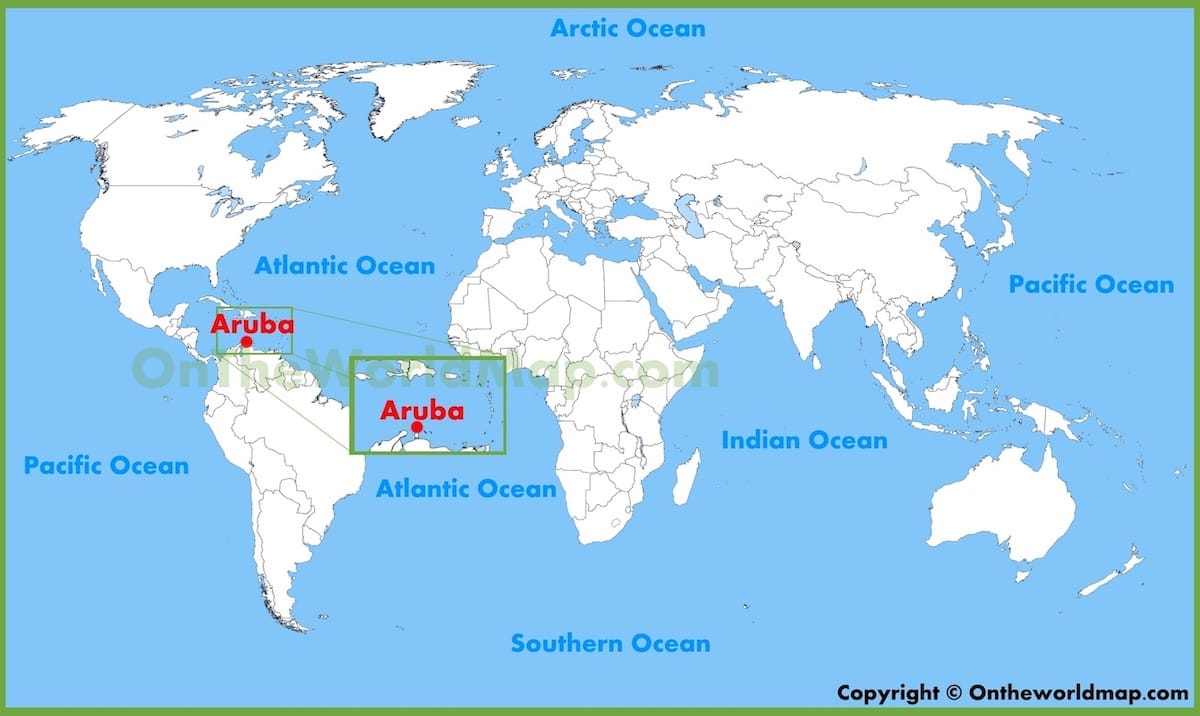
Is Aruba a U.S. Territory?
No, Aruba does not belong to the U.S., which means you’ll need a passport in most cases.
Although Aruba maintains strong economic and cultural ties with the United States, it is an autonomous entity with its own government, distinct from the U.S. territorial system. Aruba has its own constitution and is responsible for its internal affairs, while the Kingdom of the Netherlands oversees defense, foreign affairs, and other matters of broader significance.
Aruba enjoys a relationship with the United States under the U.S.-Aruba Friendship and Cooperation Treaty, which promotes cooperation in various areas such as tourism, trade, investment, and law enforcement. This treaty allows for certain privileges and benefits for citizens of both countries but does not confer U.S. territorial status on Aruba.
Is Aruba a Country?
Similar questions people often ask are “What country is Aruba in”, and “What country is Aruba”?
Yes, Aruba is a country!
To be exact, Aruba is a constituent country, meaning that it’s part of a larger country or federation. Together with the Netherlands (located in Europe, also known as “Holland”), Sint Maarten (Saint Martin) and Curaçao, Aruba is part of the Kingdom of the Netherlands.
The head of state of Aruba is King Willem-Alexander of the Netherlands.
His birthday celebration is one of Aruba’s national holidays and takes place every year on April 27 (King’s Day, previously known as Queen’s Day.)
What Continent is Aruba in?
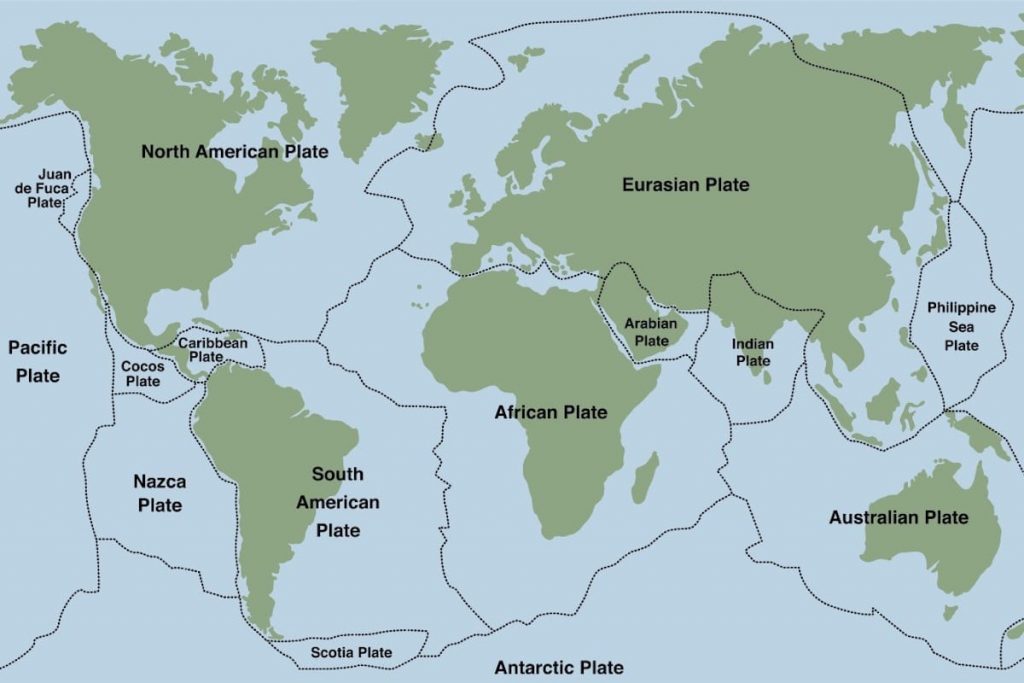
Aruba is not part of a continent.
However, it is part of the Caribbean Region which is located on the Caribbean Plate, a small tectonic plate that is located in the Caribbean Sea and the surrounding region. It is bounded by the North American Plate to the north, the South American Plate to the south, and the Cocos Plate to the west.
The Caribbean Plate is an oceanic plate, meaning that it is made up of thin, dense lithosphere (the outermost layer of the Earth) that is mostly composed of solid rock.
The movement of the Caribbean Plate has shaped the geology of the Caribbean region, including the formation of mountain ranges, volcanoes, and earthquakes. The Caribbean Plate is also home to the Bahamas, Cuba, and Hispaniola (which is shared by Haiti and the Dominican Republic).
What Time Zone is Aruba in?
Aruba is in the Atlantic Standard Time (AST) time zone. Atlantic Standard Time is a time zone that is used in the Caribbean region, and it is four hours behind Coordinated Universal Time (UTC). This means that when it is 12:00 noon (UTC) it is 8:00 am (AST) in Aruba. In other words, New York is 1 hour behind of Aruba.
Aruba does not observe Daylight Saving Time, so the time in Aruba does not change during the year. This means that the time in Aruba is always the same as in the AST time zone, regardless of the time of year.
The current time in Aruba is:
How Big is Aruba?
The island is rather small. It’s only 19 miles long.
Aruba has a land area of approximately 180 square kilometers (70 square miles). If you’d go from the island’s south-eastern tip to its north-western tip, you will only have traveled about 30 kilometers (19 miles). Aruba is just over 8 kilometers (5 miles) wide at its widest point. By car, you can go around the entire island in just a few hours. In fact, Aruba is the smallest of the “ABC Islands”.
The smallest state in the US, Rhode Island, has an area of about 4,002 square kilometers (1,545 square miles), making it over 22 times larger than Aruba.
Aruba’s size is comparable to individual cities or counties within larger US states. For example, the land area of Aruba is smaller than cities such as Houston, Texas (1,651 square kilometers/637.5 square miles) or Los Angeles, California (1,302 square kilometers/502.7 square miles).
Does Aruba Have any Mountains?
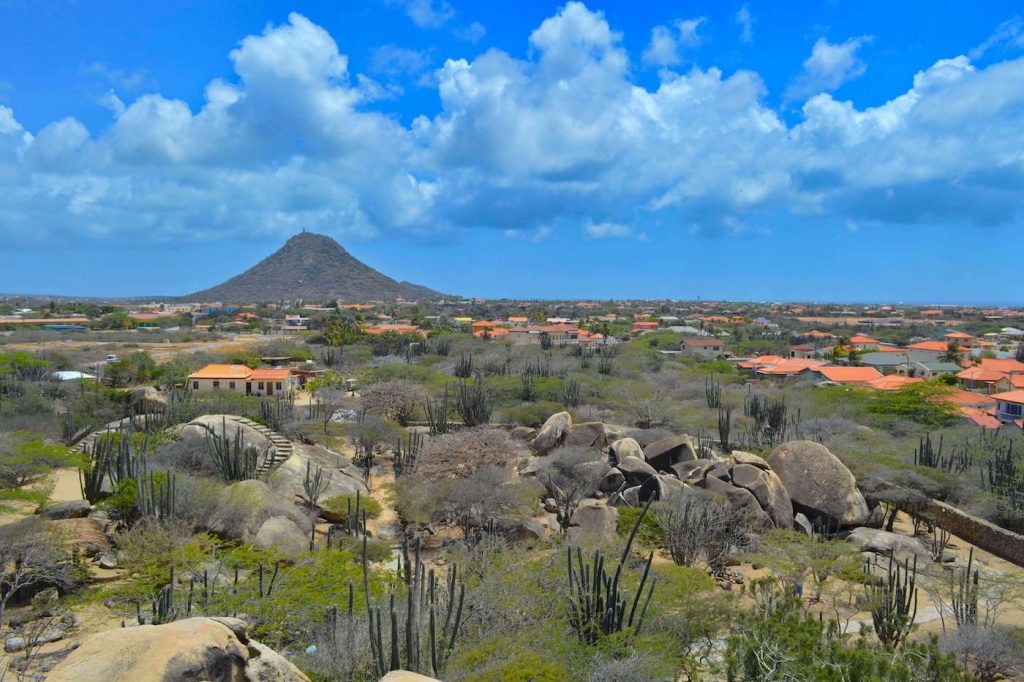
Absolutely! The island features two mountains actually, they’re named Hooiberg and Jamanota. Hooiberg is a volcanic mountain that looks like a haystack, its height is about 165 meters (541 ft). It’s the second highest mountain on the island. Jamanota is the highest point on the island, with a height of 188 meters (617 ft). It is located in Arikok National Park.
How do You Pronounce “Aruba”?
Good question! Like so: “Ah-ROO-Bah”. No real need to roll your R (but most locals do)!
Remember that Beach Boys song that goes “Aruba, Jamaica, ooh I want to take you to Bermuda, Bahama…”?
That’s exactly how you pronounce “Aruba”.
What Are the ABC Islands?
The “ABC Islands” are made up of Aruba, Bonaire, and Curaçao.
These three Caribbean islands are part of the Lesser Antilles, together with the Virgin Islands, Saint Martin, Guadeloupe, Grenada, Barbados, and Trinidad & Tobago. Aruba and the other Dutch islands like Saba, St. Eustatius, and St. Maarten in the Caribbean are often called the Netherlands Antilles or the “Dutch Caribbean”. From Aruba, Curaçao can be reached via a short flight of only 80 kilometers which should take no longer than 40 minutes. The island of Bonaire also conveniently lies within reach with a distance of only 175 kilometers. If you’re staying in Aruba long enough, Bonaire and Curaçao are perfect escapades for day trips or weekend trips.
What is the Capital of Aruba?

The capital of Aruba is Oranjestad, which is Dutch for “City of Orange”, or “Orange City.”
It’s pronounced like “Oh-RUN-Ya-Stut”. Something like that!
Oranjestad, founded in 1796, is located in the southwest of the island. Oranjestad has a little over 30.000 inhabitants and is Aruba’s largest city. Other smaller cities are Paradera, San Nicolas, Noord, Santa Cruz, and Savaneta. Aruba’s major and only national airport is Reina Beatrix International Airport, located in Oranjestad. Aruba even has an oil refinery that is located at the southwestern part of Aruba, close to San Nicolas. Most of the hotels are located north of Oranjestad. But also in the vicinity of the city, hotels and other types of accommodation are available.
What Language Do They Speak in Aruba?
The official languages of Aruba are Dutch and Papiamento.
Papiamento is a Portuguese-based Creole language, spoken on Aruba, Bonaire, and Curaçao. The language contains words from English, Dutch, Portuguese, Spanish and several African languages.
Thanks to international tourism, many people in Aruba also know how to speak English quite well. Other languages spoken on the island are Portuguese, Chinese, German, and Spanish. French is also spoken, albeit in small communities.
Check out the video below to learn more about the origins of Papiamento.
What is the Population of Aruba?
For 2019, the estimated population of Aruba is approximately 106,000. The country’s population growth rate is 0.36%. Aruba’s population density is just under 600 per square kilometer.
What is Aruba Weather Like?
Aruba weather conditions are classified as tropical with a fairly constant temperature of 82 degrees Fahrenheit (28 degrees Celsius) year round.
Temperature differences between day and night and summer and winter are a mere 38 degrees Fahrenheit (4 degrees Celsius). Constant trade winds coming from the Atlantic Ocean cool the island considerably.
May is usually the hottest month with an average temperature of 83°F (28.5°C). The “coldest” month is January at 80°F (26.5°C). The wettest month is November with an average rainfall of 90mm. The best month to swim in the Caribbean Sea is in October when the average sea temperature reaches 85°F (29°C).
Aruba lies south of the hurricane belt, and the island is influenced by the fringe effects of tropical storms in the area on occasion, causing dangerous swimming and surfing conditions at worst.
What is the Currency in Aruba?
The currency in Aruba is the Aruban florin (AWG). The florin is pegged to the United States dollar at a fixed exchange rate of 1.79 florins to 1 US dollar. As Aruba’s economy heavily relies on tourism, which provides a steady stream of foreign exchange earnings, Aruba has not experienced a currency crisis in its recent history.
This chart illustrates the pegging of the Aruban florin:
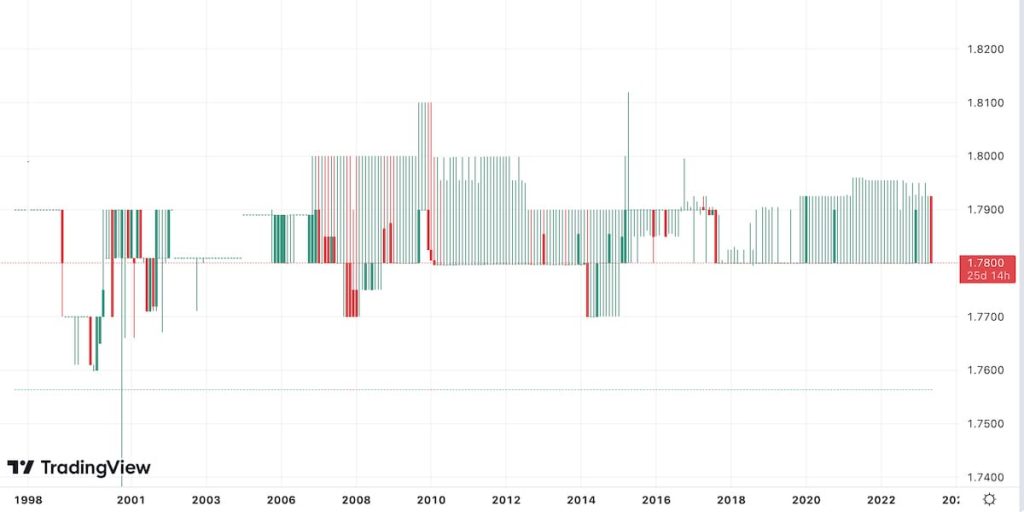
The florin is divided into 100 cents. Coins come in denominations of 5, 10, 25, and 50 cents, as well as 1 and 2.5 florins. Banknotes come in denominations of 5, 10, 25, 50, and 100 florins. The florin is widely accepted on the island, and US dollars are also widely accepted in tourist areas.
It is a good idea to exchange some money or obtain local currency upon arrival in Aruba, as it can be more convenient for making purchases and paying for services.
Most credit cards are widely accepted in Aruba, particularly in tourist areas. Major credit card brands such as Visa, Mastercard, and American Express are generally accepted at most hotels, restaurants, and other businesses.
Is Aruba Expensive?
The cost of a trip can vary widely depending on a variety of factors such as the time of year you visit, how you choose to travel, where you stay, and what activities you participate in.
Some aspects of a trip to Aruba, such as airfare, can be more expensive, while others, such as food and local transportation, may be more affordable.
In general, Aruba is considered a mid-priced Caribbean destination, with prices that are higher than some other nearby islands but lower than others. It is worth considering your budget and researching the costs of various aspects of a trip to Aruba in order to get a sense of what you can expect to pay.
Is Aruba Safe?
Aruba is generally considered to be a safe place to visit. The crime rate on the island is relatively low, and tourists generally do not experience any significant safety issues.
Some common crimes that can occur in Aruba, as in any destination, include petty theft such as pickpocketing and purse snatching, as well as more serious crimes such as robbery and assault.
As with any destination, it is always a good idea to be cautious and aware of your surroundings. You should take standard precautions such as not leaving valuable items unattended and being aware of your surroundings when walking alone at night. It is also a good idea to keep a copy of your passport in a safe place, as well as to familiarize yourself with the local laws and customs.
Overall, if you use common sense and follow basic safety precautions, you should have a safe and enjoyable visit to Aruba.
The Aruban Economy
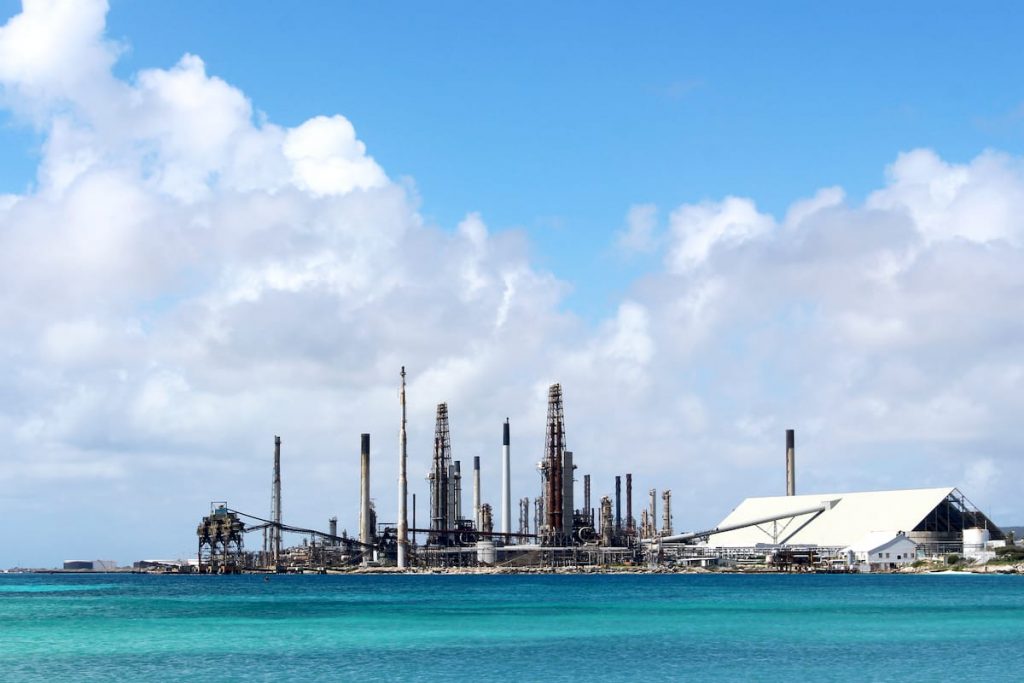
Aruba generates its revenue primarily through tourism and related industries. The island’s breathtaking beaches, favorable climate, and well-established tourism infrastructure attract a significant number of visitors each year.
Tourism serves as the backbone of Aruba’s economy, as tourists contribute to the local economy through their spending on accommodations, dining, shopping, entertainment, and various activities.
Aruba’s hospitality industry plays a crucial role in its economic prosperity. According to the Aruba Tourism Authority, Aruba welcomes over 700,000 visitors annually and 500,000 cruise ship passengers. Approximately 70% of those visitors are from the United States. Also, visitors from Canada are contributing a large part to the number of total visitors who would like to spend their vacation on the island.
In addition to tourism, Aruba benefits from a thriving retail sector. The island offers diverse shopping opportunities, including bustling local markets, modern shopping malls, and duty-free shopping areas. Retail businesses capitalize on both tourist spending and the purchasing power of local residents, contributing to Aruba’s economic growth.
The island’s culinary scene also plays a significant role in revenue generation. Aruba is renowned for its diverse range of restaurants, cafes, and bars, offering a wide array of cuisines to satisfy the tastes of both visitors and locals. These dining establishments contribute to the island’s economy by attracting customers and creating employment opportunities.
Furthermore, Aruba serves as an offshore financial center, attracting international businesses and offering financial services such as banking, insurance, and asset management. These activities contribute to the island’s economy through the generation of fees, taxes, and employment.
While tourism and related industries dominate Aruba’s revenue streams, the island also had a small oil refining industry. The Valero Energy refinery on the island processed crude oil and provided additional income and employment opportunities.
